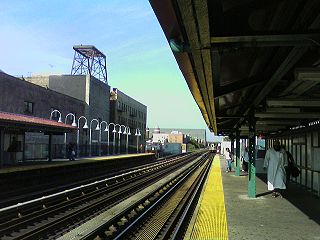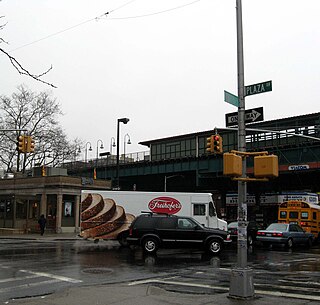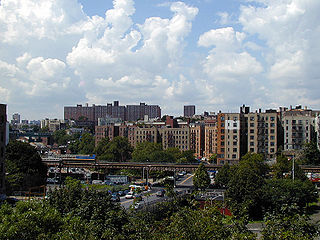
Leonard Walter Jerome was an American financier in Brooklyn, New York, and the maternal grandfather of Winston Churchill.

The Bedford Park Boulevard–Lehman College station is a local station on the IRT Jerome Avenue Line of the New York City Subway. Located at the intersection of Bedford Park Boulevard immediately west of Jerome Avenue in the Bronx, it is served by the 4 train at all times. It is also the only station on the Jerome Avenue Line north of 170th Street that is not located above Jerome Avenue. This station was constructed by the Interborough Rapid Transit Company as part of the Dual Contracts and opened in 1918.

The Fordham Road station is a local station on the IRT Jerome Avenue Line of the New York City Subway. Located at the intersection of Fordham Road and Jerome Avenue in the Bronx, it is served by the 4 train at all times. This station was constructed by the Interborough Rapid Transit Company as part of the Dual Contracts and opened in 1917.

The 176th Street station is a local station on the IRT Jerome Avenue Line of the New York City Subway. Located at the intersection of 176th Street and Jerome Avenue in the Bronx, it is served by the 4 train at all times. This station was constructed by the Interborough Rapid Transit Company as part of the Dual Contracts and opened in 1917.

The 170th Street station is a local station on the IRT Jerome Avenue Line of the New York City Subway. Located at the intersection of 170th Street and Jerome Avenue in the Bronx, it is served by the 4 train at all times. This station was constructed by the Interborough Rapid Transit Company as part of the Dual Contracts and opened in 1917.

Highbridge is a residential neighborhood geographically located in the central-west section of the Bronx, New York City. Its boundaries, starting from the north and moving clockwise, are the Cross-Bronx Expressway to the north, Jerome Avenue to the east, Macombs Dam Bridge to the south, and the Harlem River to the west. Ogden Avenue is the primary thoroughfare through Highbridge.

Bedford Park is a residential neighborhood in the northwest Bronx, New York City, adjacent to the New York Botanical Garden. Its boundaries, starting from the north and moving clockwise are: Mosholu Parkway to the north, Webster Avenue to the east, East 196th Street to the south, and Jerome Avenue to the west.
The IRT Jerome Avenue Line, also unofficially known as IRT Woodlawn Line, is an A Division New York City Subway line mostly along Jerome Avenue in the Bronx. Originally an Interborough Rapid Transit Company-operated route, it was built as part of the Dual Contracts expansion and opened in 1917 and 1918. It is both elevated and underground, with 161st Street–Yankee Stadium being the southernmost elevated station. The line has three tracks from south of the Woodlawn station to the 138th Street–Grand Concourse station. The Woodlawn Line also has a connection to the Jerome Yard, where 4 trains are stored, just north of the Bedford Park Boulevard–Lehman College station.

Saint Raymond's Cemetery is a Catholic cemetery at 2600 Lafayette Avenue in the Throggs Neck and Schuylerville sections of the Bronx, New York City, United States. The cemetery is composed of two separate locations: the older section, and the newer section, both east of the Hutchinson River Parkway. The Bronx–Whitestone Bridge is located adjacent to the cemetery's newer section, while the neighboring Throgs Neck Bridge can be seen from a distance.

Jerome Bailey York, commonly known as Jerry York, was an American businessman, and the chairman, president and CEO of Harwinton Capital. He was the former CFO of IBM and Chrysler, and was CEO of Micro Warehouse. He was a chief aide to Kirk Kerkorian and his Tracinda investment company. In February 2006, Kerkorian helped elect York to the board of directors of General Motors, from which he had previously resigned.

Morris Heights is a residential neighborhood located in the West Bronx. Its boundaries, starting from the north and moving clockwise are: West Burnside Avenue to the north, Jerome Avenue to the east, the Cross-Bronx Expressway to the south, and the Harlem River to the west. University Avenue is the primary thoroughfare through Morris Heights.
The Bronx Lyceum was a building in the Bronx, New York City erected on the southeast corner of Third Avenue and 170th Street by Henry Zeltner in 1870 across the street from his brewery. The structure was at first known as Zeltner's Hall and was surrounded by a picnic park. Following the sale of the entertainment and meeting hall by the Zeltner family, the property was called Niblo's Garden, a familiar name borrowed from an early New York opera house on Broadway, near Prince Street that was razed in 1895. The building was used as a meeting hall by politicians and union members, and served variously as an entertainment hall, skating venue, and amusement park until its destruction by fire in 1929.

Jerome Avenue is one of the longest thoroughfares in the New York City borough of the Bronx, New York, United States. The road is 5.6 miles (9.0 km) long and stretches from Concourse to Woodlawn. Both of these termini are with the Major Deegan Expressway which runs parallel to the west. Most of the elevated IRT Jerome Avenue Line runs along Jerome Avenue. The Cross Bronx Expressway interchanges with Jerome and the Deegan. Though it runs through what is now the West Bronx neighborhood, Jerome Avenue is the dividing avenue between nominal and some named "West" and "East" streets in the Bronx; Fifth Avenue, and to a lesser extent, Broadway, also splits Manhattan into nominal "West" and "East" streets.

Tim Rollins was an American artist who together with the art collaborative K.O.S. formed the art-group Tim Rollins and K.O.S.
Jerome A. Chazen was an American businessman who was the founder and chairman of Chazen Capital Partners. He was also one of four and last surviving founders of Liz Claiborne.

The Church of St. Jerome is a Roman Catholic parish church under the authority of the Roman Catholic Archdiocese of New York, located at 230 Alexander Avenue, Mott Haven, Bronx, New York City.
Morris Mohr was an American lawyer and politician from New York.
Bernard C. McDonnell was an American lawyer and politician from New York.
Rinaldo Paluzzi was an American-Spanish Abstract Art and Geometric abstraction painter and sculptor in the post-World War II era. He was born in Greensburg, Pennsylvania, and died in Madrid, Spain.

The Riverside Memorial Chapel is an American Jewish funeral home chain with their main facility at 180 West 76th Street on the Upper West Side of Manhattan, New York City. The company has been owned by Service Corporation International since 1971.














